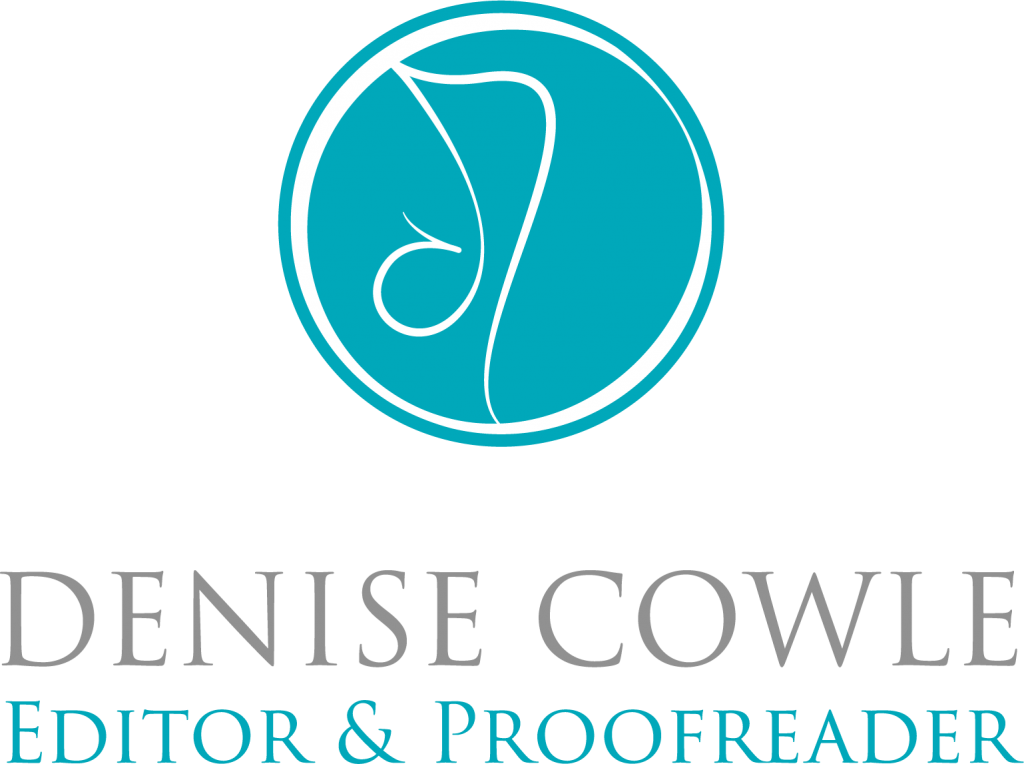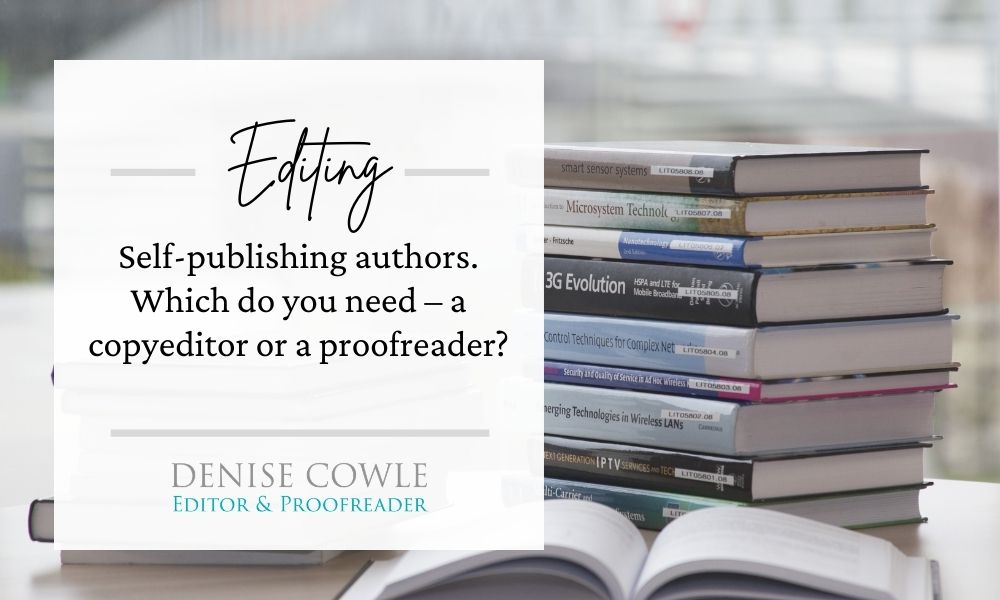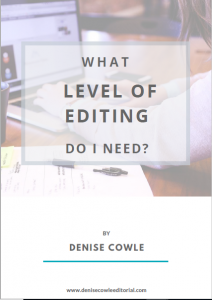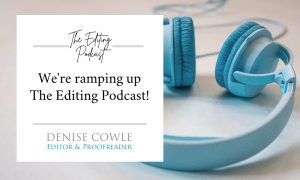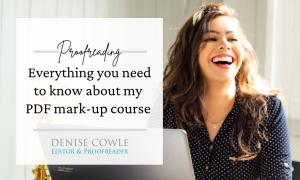
If you’re planning on self-publishing your book you probably already know that it will need some help from a copyeditor or proofreader to prepare it for publication. But what does that mean? And why is it important?
If you would prefer to listen, in this episode of The Editing Podcast Louise Harnby and I discuss the different levels of editing.
Copyediting and proofreading are two separate stages of manuscript preparation and quality control in the traditional publishing process. This is when your writing is smoothed and polished, and any errors taken care of, to make it ready for printing and publication.
If you have a deal with a mainstream publisher (Congratulations!) then they will take care of this process once you’ve handed over your manuscript.
However, when you’re self-publishing the responsibility for that preparation lies with you, and it’s important that you get the appropriate editorial support at the right stage in the process.
Making the right decision when hiring a professional copyeditor and/or proofreader means understanding what each can do for your book. You can then decide what type of support you need and work out what the costs are likely to be.
Engaging professional editorial help can account for a good chunk of your self-publishing budget, so you want to feel confident that you’ve invested it wisely.
So, what is the difference between copyediting and proofreading? Let’s look first at copyediting.
What is a copyeditor, and what does a copyeditor do?
Once you’ve finished your book – and preferably after you’ve had some feedback from reliable friends or colleagues and made revisions based on it – you hand it over to a copyeditor. It’s their job to clean up your writing and make sure it’s the best it can be for your intended audience.
Copyediting means ensuring that the content makes sense, reads clearly and well, and is consistent in its tone and style.
This can involve reordering and restructuring your sentences, perhaps shortening an overly long sentence or combining shorter ones to improve the flow.
Has your cutting-and-pasting of chunks of text resulted in missing or double words, or incomplete sentences? Or have you mistakenly copied rather than cut, meaning whole sentences or paragraphs have been repeated?
Your editor’s fresh eyes will spot this, when you have read it so many times that you read what you expect to see, rather than what’s actually there on the page.
Is there subject–verb agreement in your sentences? Have you been consistent in your choice of tense? Have you placed your modifiers correctly, or are they dangling?! Your copyeditor will check these finer grammar points for you.
Be reassured that dealing with these points won’t strip the life out of your writing, or make it dull, overly formal and bland. Sensitive editing will remove all the stumbling blocks that may catch your readers and distract them from what you’re saying. It will polish your words until they sparkle and let your message shine through.
If you have a preferred style guide, or you have created a style sheet, your copyeditor will make sure that it’s adhered to, and that spelling, capitalisation, hyphenation and punctuation are consistent, especially if several people have contributed to the book.
[Related content: Worry-free writing: what is a style sheet and why do I need one?]
It may be that your editor needs to sort out and order the headings and subheadings of a longer document or book. Any references and bibliography will need attention too, to make sure they are correctly styled and cited.
All this should be done before any design or layout, and usually happens in a Word document. Your editor will use the Track Changes function so that you can see what they’ve done and reject any changes you don’t agree with.
Copyediting shouldn’t be done in a PDF, as changes at this stage can be difficult, time-consuming and expensive.
What is a proofreader, and what does a proofreader do?
Once the copy-edited document has been designed and laid out, your proofreader is the final gatekeeper before the ‘publish’ button is pressed.
They are the last set of eyes on your book before it goes live, and it’s their job to check for any errors or omissions that may have been missed at the copyediting stage, or those which have been introduced during the design and layout process.
Your proofreader will also check that
- the style guide (if there is one) has been followed
- headers and footers are correct
- chapter titles and page numbers in the table of contents match up with the rest of the document
- any cross-referencing to other pages or chapters is accurate
- figures and tables are labelled and captioned correctly
- in-text references to figures and tables are correct
- the spelling, punctation and grammar are A1.
For more detail on the proofreading process, you can listen to this episode of The Editing Podcast.
Can you combine copyediting and proofreading?
What if you think you need a combination of copyediting and proofreading? Is proof-editing a thing?
Yes, it is. Outside the traditional publishing world – and, increasingly, inside it too – the lines between the two roles are blurred. Small businesses, big organisations, charities – anyone who is producing content – may have a need for a more individualised service.
It’s not uncommon for editors to do what is known as proof-editing – a bit more intervention than a proofread, but not a full-blown copy-edit.
If you write fairly clean copy that needs a fresh eye to proofread it, but which will also benefit from small changes to sentence structure or rewording to improve the reader experience, then this may be for you.
This doesn’t just apply to book-length writing.
You may be repurposing other content – perhaps using the transcript of a video for a blog post. Even if the transcription service removes all the ums and ers, you may still find that you’re left with incomplete sentences or repetition that, while effective in your video, isn’t appropriate for a blog post.
Do I need copyediting, or proofreading, or proof-editing?
If you’re not sure what editorial help you need, ask.
An editor is there to help you, and it’s vital that you are both on the same page (literally) before the work starts.
‘Proofreading’ is often used by indie authors as a general term for ‘fix my writing’, so a discussion around what your requirements are is absolutely essential to making sure that you get the level of editing you need.
The last thing you want is to hand over your writing for what you thought was a little bit of light pruning and it comes back having been cut to the bone. Some writers want that amount of intervention, but many don’t.
We can use a scalpel or a chainsaw: the choice is yours.
Deciding what is needed
A good editor will take the time to discuss your requirements with you. They will ask to see a sample of your book, or even the whole thing. Don’t worry about trying to perfect it before you hand it over – that’s like tidying the house before your cleaner arrives!
Show them the real deal, in all its glory. They will want to see a representative sample of your work so they can accurately assess what is needed.
It may be that you’ve asked for proofreading but on seeing a sample your editor thinks you need a bit more intervention to impose consistency and smooth out some of the grammar. You can then have a conversation about what your book needs, what the editor can provide, and how it fits with your budget.
The important thing is that you and your editor have all the information to agree on the editorial help you need, whatever you may call it, and how much it will cost to provide it.
For a handy summary of the different levels of editing, download my free guide to the different levels of editing.
